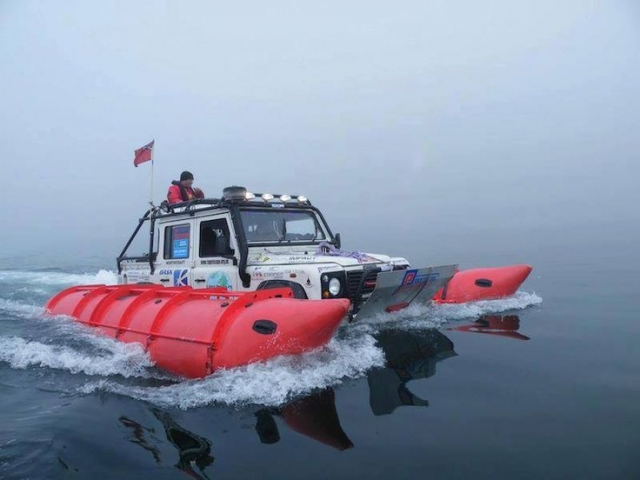These Coventry, England classics are the second oldest four-wheel-drive vehicle brand, after the Jeep, to still be wandering the planet. As such, there are owners and tuners worldwide who modify the appearance, appointments and performance of the storied Land Rover, a hardy off-roader that dates back to 1948.
While most owners are inclined to keep their go-anywhere, tough-as-nails Landys in prime operating condition, there are those who venture beyond the norm, as this group of extreme examples aptly illustrates.
We’re not exactly sure where or when this particular conversion originated, but the photo of the Rover that looks like it’s surrounded by a short curtain may have been taken at a military expo, suggesting this Land Rover hovercraft could have had a combat or support role, although there doesn’t appear to be any armament or armor plating.
A Land Rover hovercraft for the military? Crop dusting hovercraft Land Rover that blew away the insecticide. Rail-riding Land Rover that was deemed too lightweight.
This second hovercraft was intended for a different type of invasive species, insects. In modifying the Land Rover, the wheels still touched the ground for propulsion and at the same time allowed it to go over rough terrain. The design failed, as air from the surrounding cushion dispersed all the pesticide. However, the Vickers Company still used it to promote larger hovercrafts.
Rail-riding Land Rovers were more common, with the first using train wheels in place of road wheels. Intended for inspecting the railroad and for switching cars, it proved too underpowered for the latter task.
A second type with separate rail wheels proved to be quick on the tracks, but it was too light to be detected by the train monitoring system, which could be a problem. Newer versions are still around, so they most likely overcame that issue.
In 1963, Shell Oil Company had a specialized Land Rover built for its Alaskan operations and exploration of possible pipeline routes. Wide flotation-style, 33-inch tall tires were fitted to traverse the tundra, adjusted by a compressor under the body with a power take-off (PTO).
Several versions of amphibious Land Rovers (top photo) surfaced, most of them with pontoons strapped to the sides. Many Land Rover Defender models feature snorkels, that put the air intake and exhaust high enough to allow the vehicle to ford deep waters. In 1990, a fully amphibious Discovery converted for Cowes Week created a splash as it was driven into Lake Geneva to demonstrate its go-anywhere capability. Cowes Week is a world-famous sailing regatta that has taken place every year since 1826, with more than 8,000 competitors and 100,000 spectators.
Shell Oil Company went looking for oil in Alaska with this Land Rover. Amphibious Rovers seem to fairly commonplace, and they work. Tracked Rovers have been around long before Ken Block built his Raptor!
Rally America and Global Rallycross driver Ken Block’s tracked Raptor is not the first off-road vehicle to use tracks. Long before Block’s Raptor or the Subaru he built prior to that, Scotland’s Cuthbertson had fitted a Land Rover with removable tracks. Lowering the ground pressure to 1.9 pounds per square inch, this allowed the SUV to cover swampy ground.
Fitted to an 88-inch 24V FFR Series One Land Rover, there were also Cuthbertson Series Two Land Rovers. It is believed that Cuthbertson made 15 units, including three prototypes, the last one in a 72-inch wheelbase. Each track was accompanied by four skinny wheels with rubber tires. Drive sprockets replaced the road wheels, and four tracks were mounted on a sturdy subframe.
On land, by sea, and even hovering on a cushion of air, these modified Land Rovers are quintessentially British – a bit odd, very quirky, and great fodder for the question, ‘What were they thinking?’.

























